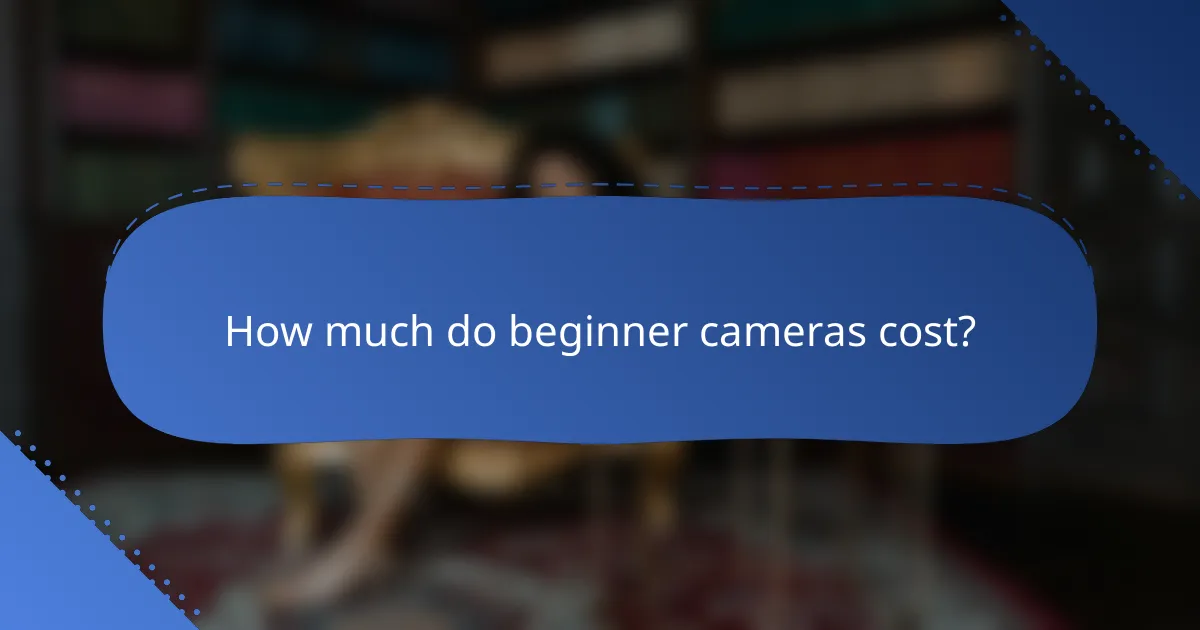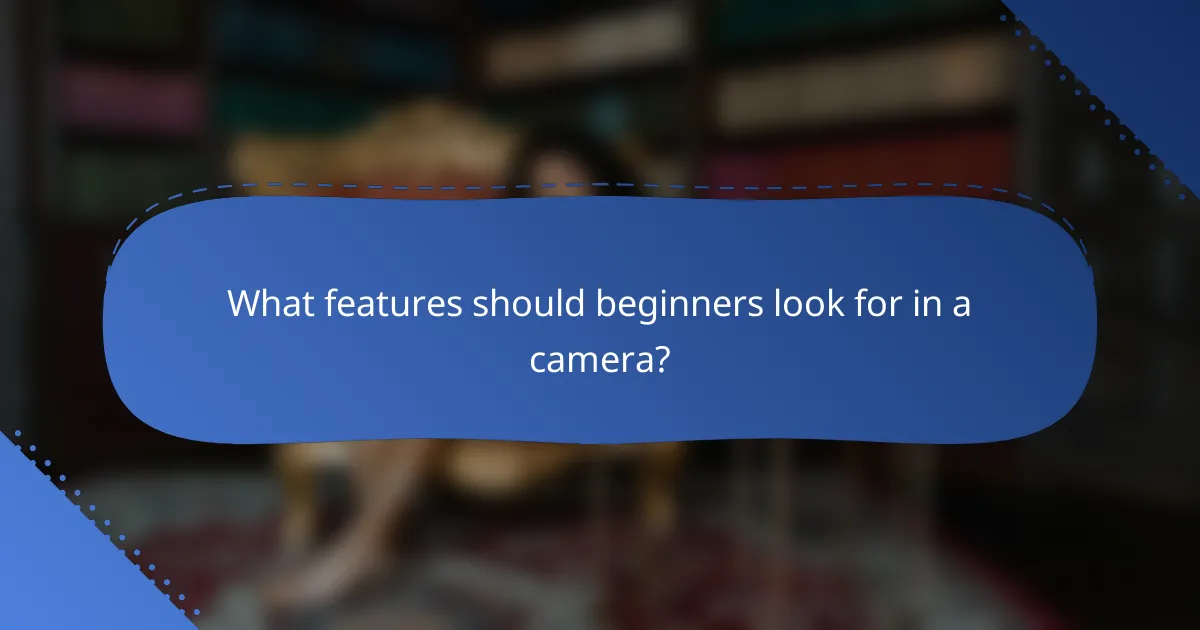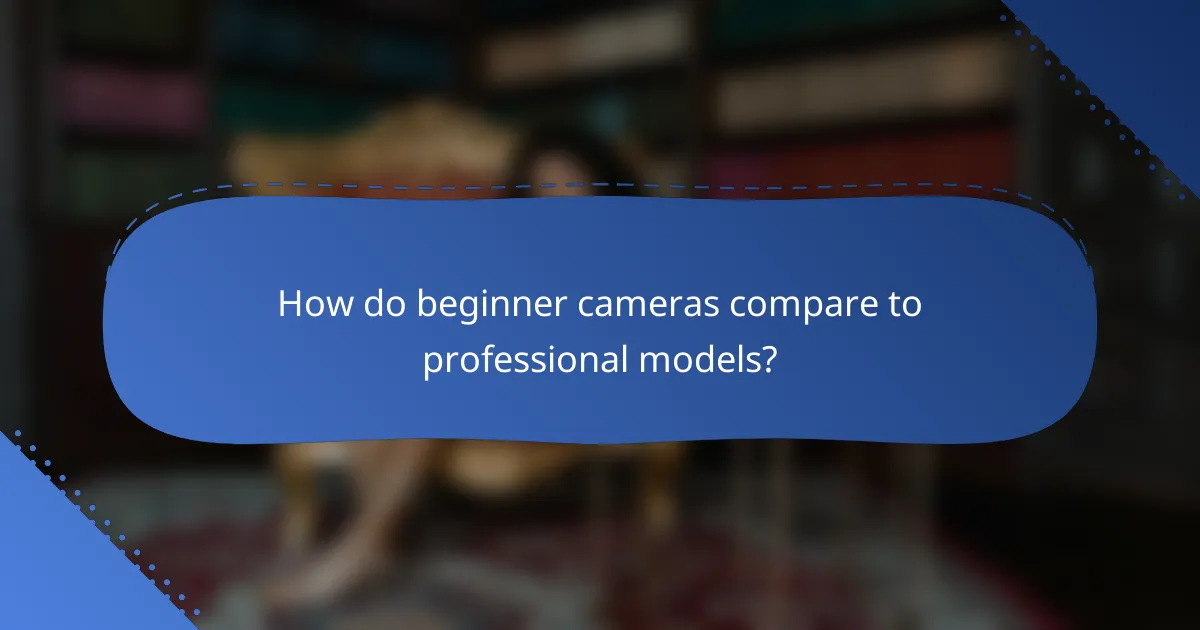Choosing the right camera as a beginner involves balancing user-friendly features, affordability, and versatility. The best beginner cameras not only help you grasp the fundamentals of photography but also deliver quality images and allow for future growth. With options ranging from entry-level DSLRs to compact models, it’s essential to consider features like image stabilization and auto-focus capabilities to enhance your learning experience.

What are the best beginner cameras for photography?
The best beginner cameras for photography combine user-friendly features, affordability, and versatility. These cameras help new photographers learn the basics while providing quality images and room for growth.
Canon EOS Rebel T8i
The Canon EOS Rebel T8i is an excellent choice for beginners due to its intuitive interface and robust features. It offers a 24.1 MP sensor, Dual Pixel autofocus, and a vari-angle touchscreen, making it easy to capture creative shots from various angles.
With built-in Wi-Fi and Bluetooth, sharing photos is straightforward. The camera also supports 4K video recording, allowing beginners to explore videography alongside photography.
Nikon D3500
The Nikon D3500 is a compact DSLR that is perfect for new photographers. It features a 24.2 MP sensor and a Guide Mode that helps users understand camera settings and photography techniques.
This camera excels in battery life, lasting for over 1,500 shots on a single charge. Its lightweight design and comfortable grip make it an ideal option for extended shooting sessions.
Fujifilm X-T200
The Fujifilm X-T200 stands out with its stylish design and retro aesthetic, appealing to many beginners. It offers a 24.2 MP sensor and a user-friendly touchscreen interface, making it easy to navigate settings and capture images.
This camera features various film simulation modes, allowing users to experiment with different looks. Its lightweight body and compact size make it convenient for travel and everyday use.
Sony Alpha a6000
The Sony Alpha a6000 is a mirrorless camera that provides fast autofocus and continuous shooting at 11 frames per second, making it great for capturing action shots. It has a 24.3 MP sensor and a compact design, perfect for beginners looking for portability.
With built-in Wi-Fi, sharing images is simple. The camera also supports a range of lenses, allowing users to expand their photography skills as they progress.
Olympus OM-D E-M10 Mark III
The Olympus OM-D E-M10 Mark III is a stylish mirrorless camera that combines advanced features with ease of use. It features a 16 MP sensor and in-body image stabilization, which helps reduce blur in photos, especially in low-light conditions.
This camera includes various art filters and scene modes, encouraging creativity. Its compact size and lightweight design make it an excellent choice for beginners who want to carry their camera everywhere.

How much do beginner cameras cost?
Beginner cameras typically range from a few hundred to over a thousand dollars, depending on the type and features. Entry-level DSLRs, mirrorless cameras, and compact models each have different price points that cater to various needs and budgets.
Entry-level DSLR prices
Entry-level DSLRs generally cost between 400 to 800 USD. These cameras offer interchangeable lenses and manual settings, making them suitable for beginners wanting to learn photography. Popular models often include a kit lens, which can add to the overall value.
When shopping for a DSLR, consider the brand’s ecosystem, as lenses and accessories can vary significantly in price. Look for deals during seasonal sales or consider buying refurbished models to save money.
Mirrorless camera pricing
Mirrorless cameras for beginners typically range from 500 to 1,200 USD. They are lighter and more compact than DSLRs while still offering high-quality images and video capabilities. Many mirrorless options come with advanced features like faster autofocus and better video performance.
While the initial investment may be higher, mirrorless systems often provide a more modern user experience. Check for bundles that include lenses and accessories to maximize your purchase.
Budget compact cameras
Budget compact cameras can be found for as low as 100 to 500 USD. These cameras are user-friendly and ideal for casual photography, making them perfect for beginners who want a simple point-and-shoot experience. They often come with built-in zoom lenses and automatic settings.
When selecting a compact camera, pay attention to image quality, battery life, and ease of use. Look for models with good reviews to ensure you get a reliable device without overspending.

What features should beginners look for in a camera?
Beginners should prioritize features that enhance usability and improve image quality. Key aspects include image stabilization, effective auto-focus capabilities, and built-in tutorials that guide users through the basics of photography.
Image stabilization
Image stabilization helps reduce blurriness caused by camera shake, which is crucial for beginners who may not have steady hands. Look for cameras with optical or digital stabilization systems, as these can significantly improve image clarity, especially in low-light conditions or when using zoom.
When selecting a camera, consider models that offer in-body stabilization (IBIS) or lens-based stabilization. These systems can be particularly beneficial for shooting video or capturing fast-moving subjects.
Auto-focus capabilities
Auto-focus capabilities are essential for beginners, as they simplify the process of capturing sharp images. Cameras with fast and accurate auto-focus systems can help users quickly lock onto subjects, reducing the chances of missed shots.
Look for cameras that feature phase-detection or contrast-detection auto-focus, with a higher number of focus points providing more flexibility. Some models even offer face and eye detection, which is particularly useful for portrait photography.
Built-in tutorials
Built-in tutorials can greatly assist beginners in learning how to use their camera effectively. These features often include guided modes that explain settings and techniques, making it easier to understand photography fundamentals.
Choose cameras that offer interactive tutorials or on-screen guides. This can help users gain confidence and improve their skills without needing to consult external resources constantly.

How easy are beginner cameras to use?
Beginner cameras are designed to be user-friendly, making photography accessible for novices. With intuitive controls and helpful features, these cameras allow users to focus on capturing images rather than navigating complex settings.
User-friendly interfaces
Many beginner cameras feature simple, intuitive interfaces that make it easy for users to understand and operate the device. Large buttons, clear labels, and touchscreens are common, allowing for quick adjustments without confusion.
Look for cameras with guided menus and on-screen tutorials, which can enhance the learning experience. This design approach helps beginners feel more confident as they explore different photography techniques.
Automatic shooting modes
Automatic shooting modes are a key feature of beginner cameras, enabling users to take quality photos without needing extensive knowledge of camera settings. Modes like Auto, Portrait, and Landscape adjust exposure, focus, and other parameters automatically based on the scene.
These modes allow beginners to experiment with different styles while ensuring good results. Users can gradually learn to switch to manual settings as they become more comfortable with photography basics.
Lightweight designs
Lightweight designs are essential for beginner cameras, making them easy to carry and handle. Most entry-level models weigh less than a kilogram, allowing users to take them on trips without feeling burdened.
When choosing a camera, consider its size and weight, especially if you plan to use it for extended periods. A comfortable grip and manageable weight can significantly enhance the overall user experience.

What are the advantages of mirrorless cameras for beginners?
Mirrorless cameras offer several advantages for beginners, including their lightweight design, quick shooting capabilities, and versatility with interchangeable lenses. These features make them user-friendly and adaptable for various photography styles.
Compact size
One of the primary benefits of mirrorless cameras is their compact size compared to traditional DSLRs. Without the bulky mirror mechanism, these cameras are generally lighter and more portable, making them ideal for beginners who may be overwhelmed by larger equipment.
This compactness allows for easier handling and storage, encouraging beginners to carry their camera more often. A smaller camera can fit comfortably in a bag or even a large pocket, making spontaneous photography more accessible.
Faster shooting speeds
Mirrorless cameras typically offer faster shooting speeds due to their electronic viewfinders and lack of mechanical parts. This means beginners can capture fast-moving subjects, such as children or sports, with less delay, enhancing their ability to take dynamic shots.
Many models feature continuous shooting modes that can capture several frames per second, allowing users to select the best shot from a series. This capability is particularly useful for action photography, where timing is crucial.
Interchangeable lenses
Interchangeable lenses provide significant flexibility for beginners, allowing them to adapt their camera to different shooting scenarios. Whether it’s a wide-angle lens for landscapes or a macro lens for close-ups, having options can greatly enhance creativity.
Beginners should consider starting with a versatile kit lens and gradually investing in additional lenses as they explore their photography interests. This approach helps them learn about different focal lengths and perspectives without overwhelming them with choices initially.

How do beginner cameras compare to professional models?
Beginner cameras are generally designed to be user-friendly and affordable, while professional models offer advanced features and superior image quality. The trade-off often lies in complexity, cost, and the range of capabilities, with beginners focusing on ease of use and professionals emphasizing performance and versatility.
Image quality differences
Image quality is one of the most significant distinctions between beginner and professional cameras. Beginner models typically have smaller sensors and lower resolution, which can result in less detail and poorer performance in low-light conditions. In contrast, professional cameras often feature larger sensors, higher megapixel counts, and advanced image processing capabilities, leading to sharper and more vibrant images.
For instance, a beginner camera might produce images that are satisfactory for casual use or social media, while a professional camera can deliver prints suitable for gallery exhibitions. When choosing a camera, consider what you intend to do with your photos; if high-quality prints or detailed landscapes are your goal, investing in a professional model may be worthwhile.
Additionally, professional cameras usually allow for greater control over settings such as ISO, shutter speed, and aperture, which can significantly enhance image quality. Beginners should be aware that while they may not need all these features initially, understanding them can improve their photography skills over time.
